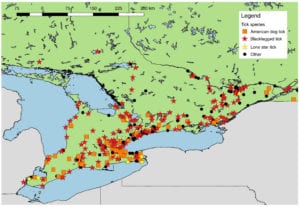
Looking outside at the snow and ice that abound, we are not really thinking about the creepy crawlers that affect our pets throughout the summer months here in Southern Ontario. But maybe we should? Typically, we think of warm summer days and long grassy areas as the concerns for tick bites, but the reality of things is that as weather patterns vary, tick season may last longer than we think, and be more difficult to predict. Any days above 4 degrees Celsius can have ticks that are sleeping under protective layers of leaf litter in forested areas start waking up and looking for a blood meal. The weather patterns this winter have meant that there have been more than a few winter days that could have ticks crawling back to life. But what does this mean for us?

Luckily, the veterinarians at the University of Guelph have been tracking ticks in Ontario since 2016 through a website called petsandticks.com. Any time a pet owner or a veterinarian finds a tick on an animal, they can submit the bug or a picture of it to the website for identification. This way, they can track where the ticks are coming from, what type of ticks they are and when they are found. The website has a summary from 2018, which gives us an idea of what we might expect this year to look like. A map is provided below that shows where ticks are being found, and shows a variety of types of ticks being found all over southern Ontario. Notably, many ticks are submitted from urban centers, so this is not just a problem for dogs running loose on farms or walking in the woods.
The graph below also shows the months that ticks were submitted for tracking. 513 ticks were submitted in 2018, and although the majority of the ticks were noted in May/June, there was a second peak in tick activity in October/November. This coincides with what we think of traditional tick season, but it is also very interesting to note that ticks were found in all 12 months of the year here in Southern Ontario. Our recommendation is usually to treat with tick preventative medications from March to November based on a pet’s exposure, but this data may mean that for certain pets, it makes sense to consider year-round tick preventative products.

The majority of ticks found were either Black Legged or American Dog Ticks, with a small number of other species being found. These are the common ticks noted in the area, and the black legged tick or deer tick is one of the species which can carry Lyme disease; a serious infection that can be transmitted to people and dogs. A few other ticks were noted, but nothing outside of normal numbers. Changes in tick populations can mean new disease risks for our animals, and these changes are currently being monitored.
Making decisions about tick bite prevention for ourselves and our pets is not a one size fits all situation. Understanding tick ecology, where they live and how we get exposed is important. Ticks are gross and getting bitten is no fun, but what the risks are for disease transmission is another important question for all of us. If you need help making decisions about protecting your pet, please ask our team to be a part of your solution and please follow the veterinarians at petsandticks.com




